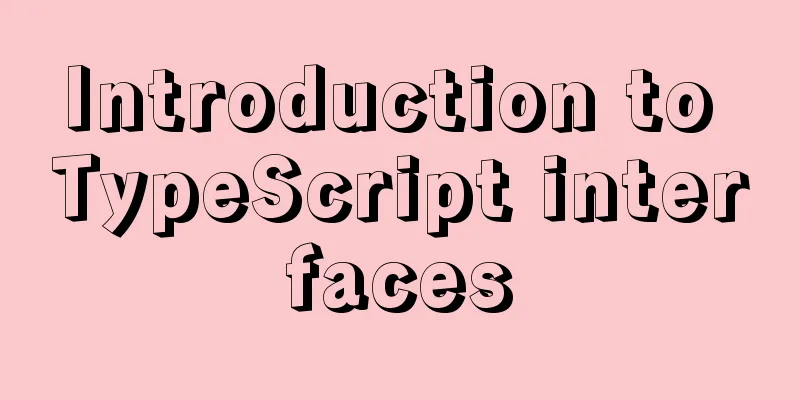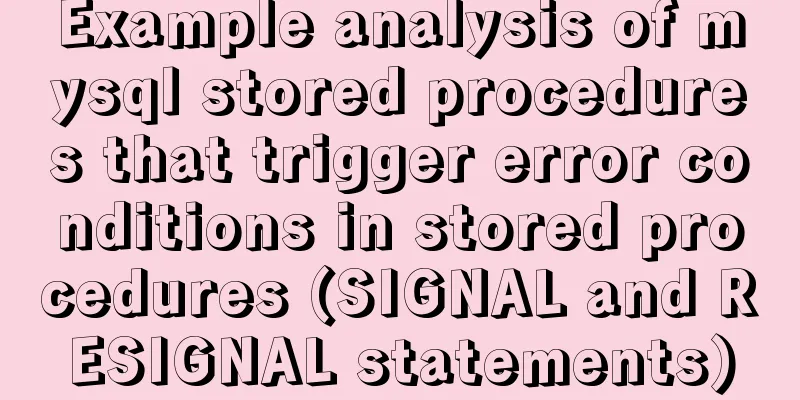Introduction to TypeScript interfaces

|
Preface: One of the core principles of TS is to type check the structures you have. The purpose of an interface is to name these types and to define a contract for your code or third-party code. The code that is finally compiled into 1. Interface definition The role of the interface is similar to type str = string This writing method cannot be applied in interfaces, where only function types, class types, and array types can be written. The sample code is as follows:
// Define a simple interface interface Person {
name: string
}
//Define the get method function getPersonName(person: Person): void {
console.log(person.name)
}
// Define the set method function setPersonName(person: Person, name: string): void {
person.name = name
}
// Define a person object let person = {
name: 'A bowl of porridge',
}
setPersonName(person, 'Yiwan Zhou')
// Modification successful getPersonName(person) // Yiwan Zhou The It is worth noting that type checking does not check the order of properties, it only requires that the corresponding properties exist and have the same type. 2. Attributes 2.1 Optional AttributesIf a property in an interface is optional, or exists only under certain conditions, you can add a ? sign next to the property name. The sample code is as follows:
;(function () {
// Define a simple interface interface Person {
name: string
// Indicates that age is optional age?: number
}
// Define a person object let person = {
name: 'A bowl of Zhou',
age: 18,
hobby: 'coding',
}
//Define the get method function getPersonName(person: Person): void {
// console.log(person.age, person.hobby) // Property 'hobby' does not exist on type 'Person'.
}
})()
At this time, we can write or not write the 2.2 Read-only properties If you want to make a property a read-only property, just add The sample code is as follows:
;(function () {
interface Person {
// Set name to read-only readonly name: string
}
// Define a person object let person = {
name: 'A bowl of Zhou',
}
// Define the set method function setPersonName(person: Person, name: string): void {
person.name = name // Cannot assign to 'name' because it is a read-only property.
}
setPersonName(person, 'a bowl of porridge')
})()
3. Class Type 3.1 Inheritance interfaceLike classes, interfaces can inherit from each other. This allows us to copy members from one interface to another, giving us more flexibility in splitting interfaces into reusable modules. Interface inheritance uses the extends keyword. The sample code is as follows:
// Define two interfaces interface PersonName {
name: string
}
interface PersonAge {
age: number
}
// Define a Person interface that inherits from the above two interfaces. Multiple interfaces are used, separated by commas. interface Person extends PersonName, PersonAge {
hobby: string
// Define a method whose return value is string
say(): string
}
let person = {
name: 'A bowl of Zhou',
age: 18,
hobby: 'coding',
// Example method say() {
return 'A bowl of Zhou'
},
}
//Define the get method function getPersonName(person: Person): void {
console.log(person.name, person.age, person.hobby)
}
getPersonName(person) // Yiwan Zhou 18 coding
Used when inheriting multiple interfaces, separated by commas. 4. Function TypeIn TS, interfaces can also describe interfaces of function types. The definition of a function type interface is like a function definition with only a parameter list and a return value type. Each parameter in the parameter list requires a name and a type. The sample code is as follows:
interface MyAdd {
(x: number, y: number): number
}
After the definition is completed, we can use this function interface like a normal interface. The sample code is as follows:
let myAdd: MyAdd = (x: number, y: number): number => {
return x + y
}
The above code is equivalent to the following function definition:
let myAdd: (x: number, y: number) => number = (
x: number,
y: number
): number => {
return x + y
}
This is the end of this article about You may also be interested in:
|
<<: A brief discussion on the fun of :focus-within in CSS
>>: Some tips for writing high-performance HTML applications
Recommend
Right align multiple elements in the same row under div in css
Method 1: float:right In addition, floating will ...
How to manually install MySQL 5.7 on CentOS 7.4
MySQL database is widely used, especially for JAV...
Comparison of the efficiency of different methods of deleting files in Linux
Test the efficiency of deleting a large number of...
Summary of Mysql slow query operations
Mysql slow query explanation The MySQL slow query...
vue-cli introduction and installation
Table of contents 1. Introduction 2. Introduction...
MySql development of automatic synchronization table structure
Development Pain Points During the development pr...
The difference between ${param} and #{param} in MySQL
The parameter passed by ${param} will be treated ...
How to install and configure SSH service in Ubuntu 18.04
Install ssh tool 1. Open the terminal and type th...
Conditional comments to determine the browser (IE series)
<!--[if IE 6]> Only IE6 can recognize <








